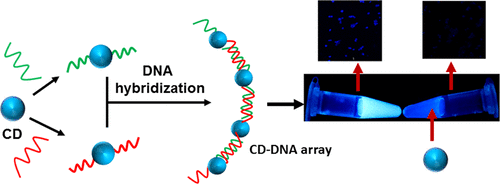当前位置:
X-MOL 学术
›
Bioconjugate Chem.
›
论文详情
Our official English website, www.x-mol.net, welcomes your feedback! (Note: you will need to create a separate account there.)
Creation of Linear Carbon Dot Array with Improved Optical Properties through Controlled Covalent Conjugation with DNA.
Bioconjugate Chemistry ( IF 4.7 ) Pub Date : 2018-04-10 00:00:00 , DOI: 10.1021/acs.bioconjchem.8b00173 Sonam Kumari 1 , Apurv Solanki 2 , Saptarshi Mandal 1 , Deepa Subramanyam 2 , Prolay Das 1
Bioconjugate Chemistry ( IF 4.7 ) Pub Date : 2018-04-10 00:00:00 , DOI: 10.1021/acs.bioconjchem.8b00173 Sonam Kumari 1 , Apurv Solanki 2 , Saptarshi Mandal 1 , Deepa Subramanyam 2 , Prolay Das 1
Affiliation

|
Controlled conjugation of fluorescent carbon dots (CDs) with DNA and subsequent fabrication of the CDs into an array through hybridization mediated self-assembly in the solution phase is reported. Covalent conjugation of CD with DNA and the subsequent array formation change the mobility of the CD-DNA array in gel electrophoresis and HPLC significantly. Interspatial distance in the CD-DNA array is tuned by the DNA sequence length and maintained at ∼8 ± 0.3 nm as revealed by electron microscopy studies. An increase in fluorescence lifetime by ∼2 ns was observed for the CD-DNA array compared to a solitary CD, vis-á-vis better imaging prospects of HEK293 cells by the former. Thus, the array displays improved fluorescence and unhindered cell penetration.
中文翻译:

通过与DNA的共价共轭缀合,创建具有改善的光学性质的线性碳点阵列。
报告了荧光碳点(CD)与DNA的控制共轭,以及随后在溶液相中通过杂交介导的自组装将CD制成阵列的过程。CD与DNA的共价缀合以及随后的阵列形成极大地改变了CD-DNA阵列在凝胶电泳和HPLC中的迁移率。CD-DNA阵列中的空间间距可通过DNA序列长度进行调整,并保持在〜8±0.3 nm,如电子显微镜研究所揭示。与单独的CD相比,CD-DNA阵列的荧光寿命增加了约2 ns,而前者对HEK293细胞的成像前景更好。因此,该阵列显示出改善的荧光和不受阻碍的细胞渗透。
更新日期:2018-04-10
中文翻译:

通过与DNA的共价共轭缀合,创建具有改善的光学性质的线性碳点阵列。
报告了荧光碳点(CD)与DNA的控制共轭,以及随后在溶液相中通过杂交介导的自组装将CD制成阵列的过程。CD与DNA的共价缀合以及随后的阵列形成极大地改变了CD-DNA阵列在凝胶电泳和HPLC中的迁移率。CD-DNA阵列中的空间间距可通过DNA序列长度进行调整,并保持在〜8±0.3 nm,如电子显微镜研究所揭示。与单独的CD相比,CD-DNA阵列的荧光寿命增加了约2 ns,而前者对HEK293细胞的成像前景更好。因此,该阵列显示出改善的荧光和不受阻碍的细胞渗透。


























 京公网安备 11010802027423号
京公网安备 11010802027423号